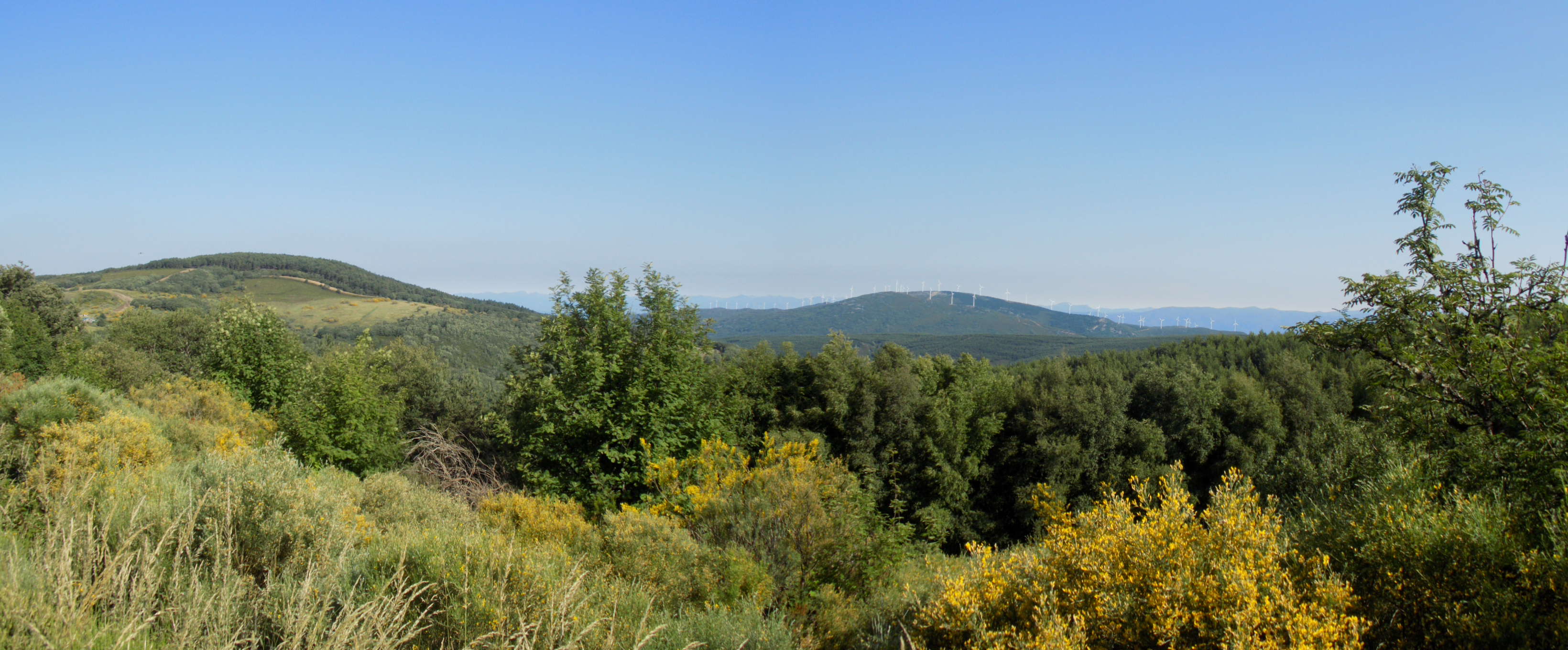Astorga is a very beautiful place. This is clear enough already as you are approaching it and is fully confirmed when you enter the centre of the town. Under any normal circumstances, I would have loved visiting the place and its edifices, as well as drinking coffee or clara in one of the local bars. This way, I was just walking slowly along the Way, with occasional stops in order to take a photo or two.
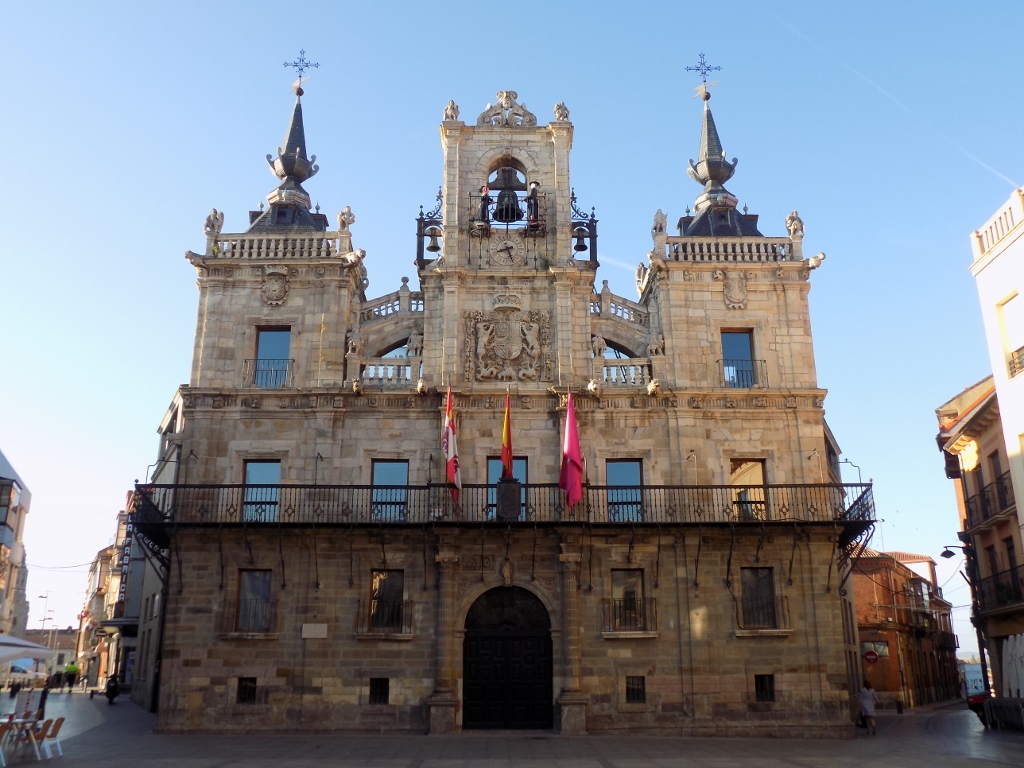 The Town Hall
The Town Hall
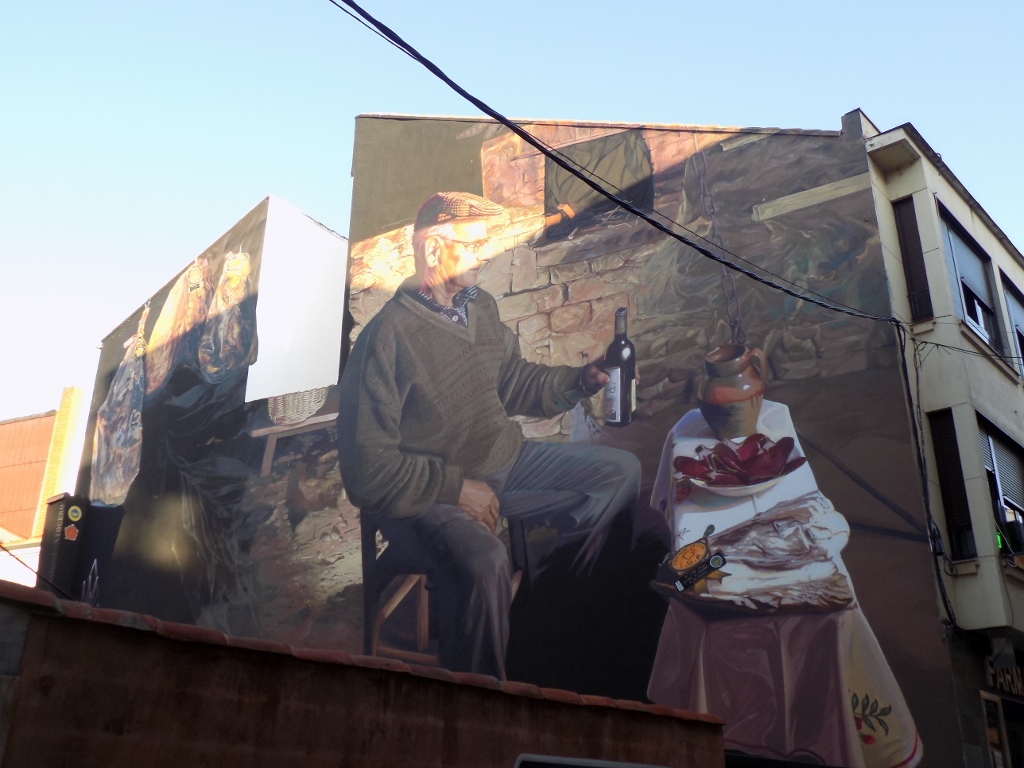 A mural on one of the houses along the Way
A mural on one of the houses along the Way
When you cross the square with the Town Hall, the Way goes again along narrow streets and then, almost suddenly, it gets to another, larger square with the Cathedral, as well as the Episcopal Palace designed by famous Gaudí.
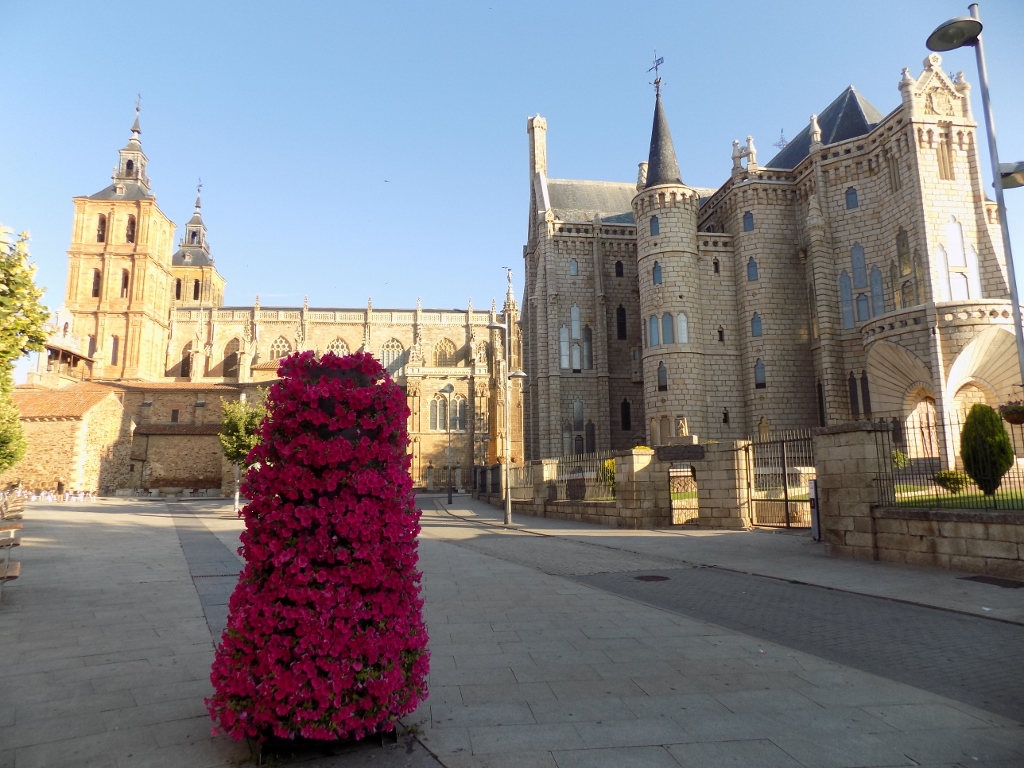 The Cathedral (left) and the Episcopal Palace (right)
The Cathedral (left) and the Episcopal Palace (right)
The three of us dispersed a little here and I wondered if we would make a break in one of the bars at the square itself. Still, by the time we got together, we had already entered the street leading away from the entrance into the Cathedral, so we agreed to continue and find some other bar to have breakfast at.
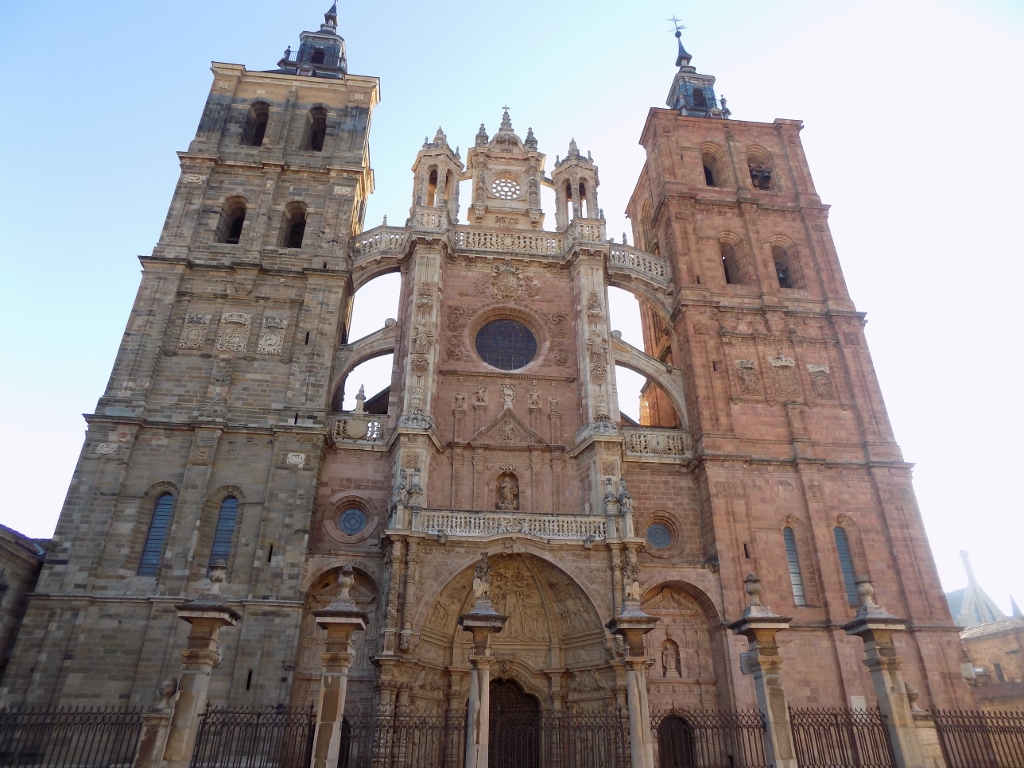 Front facade of the Cathedral
Front facade of the Cathedral
Thus, we passed by a church of rather contemporary architecture and a sign on it which wished the pilgrims to “Have a nice Way!” (Buen Camino).
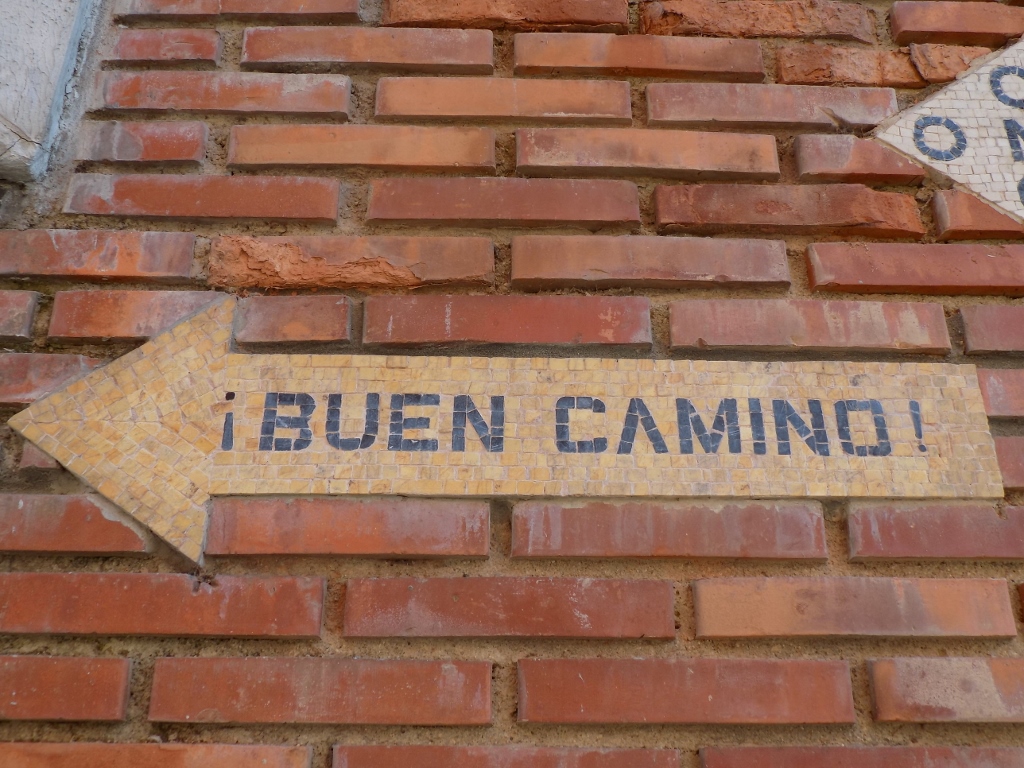 Both the sign and the good wishes
Both the sign and the good wishes
And then the time came to sit down and have a nice breakfast before leaving Astorga.
Less than 5 km farther, one gets to Murias de Reichivaldo where the Way goes along the perimeter of the village and not through the centre. Of course, there are also bars and accommodation there, but we did not hang around.
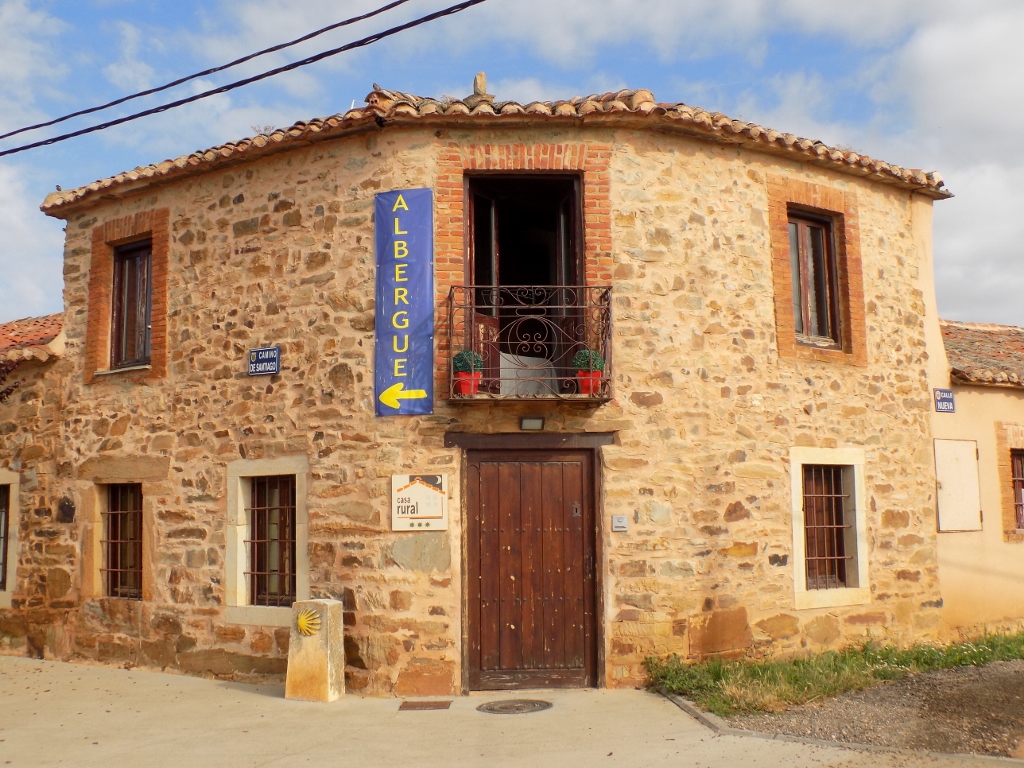 One of the albergues in Murias de Reichivaldo
One of the albergues in Murias de Reichivaldo
During the next section, Francesco and Gabriel went considerably ahead of me, since I made frequent stops in order to take photos and after that I didn’t feel like running in order to catch up. The Way mostly led straight, but along a mild constant slope.
The landscapes around the Way were simple, but with a lot of greenery and I found them to be very beautiful.
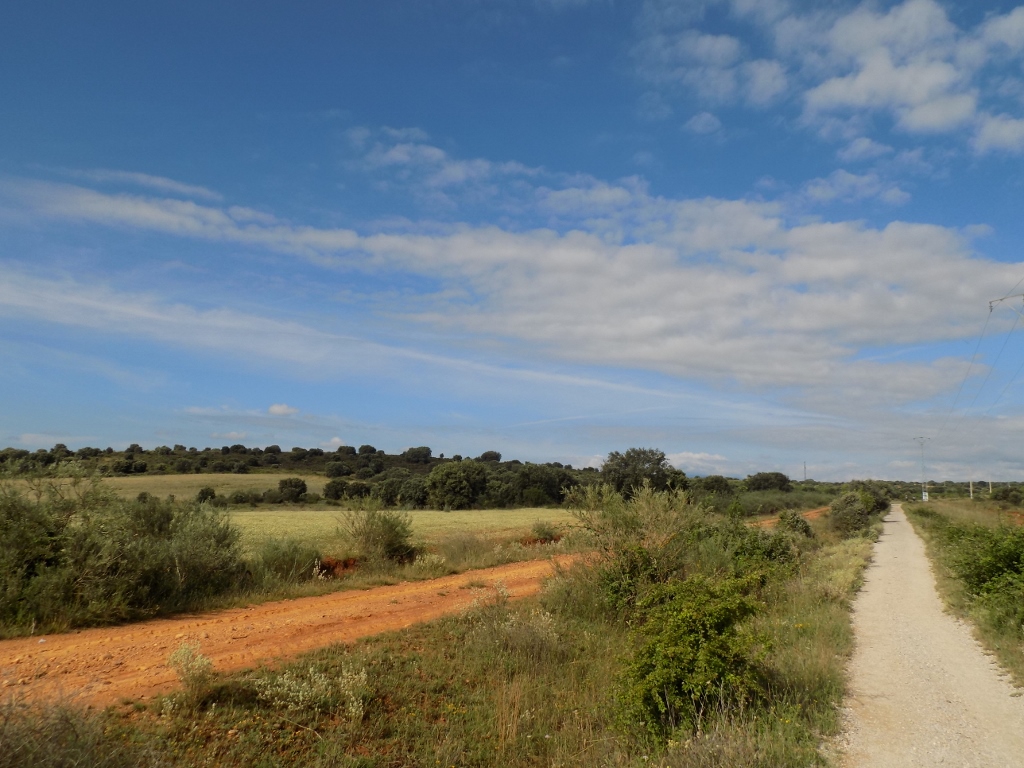 Scenery after village Murias de Reichivaldo
Scenery after village Murias de Reichivaldo
Soon I could see the glimpses of the following village and that was Santa Catalina de Somosa. There a couple of times I also encountered people coming for a walk along the Way, but in the contrary direction to the one taken by the pilgrims.
Admittedly, it is important to bear in mind that in the old times the pilgrims went both ways simply because there were no contemporary means of transportation that would take them home soon after reaching Santiago de Compostela, which is the most usual scenario nowadays. Even today, there are people, albeit very few of them, who for different reasons walk in the “opposite” direction. These that I encountered on this day when I entered Santa Catalina de Somosa simply seemed to be people who stayed at the village and then walked in its vicinity.
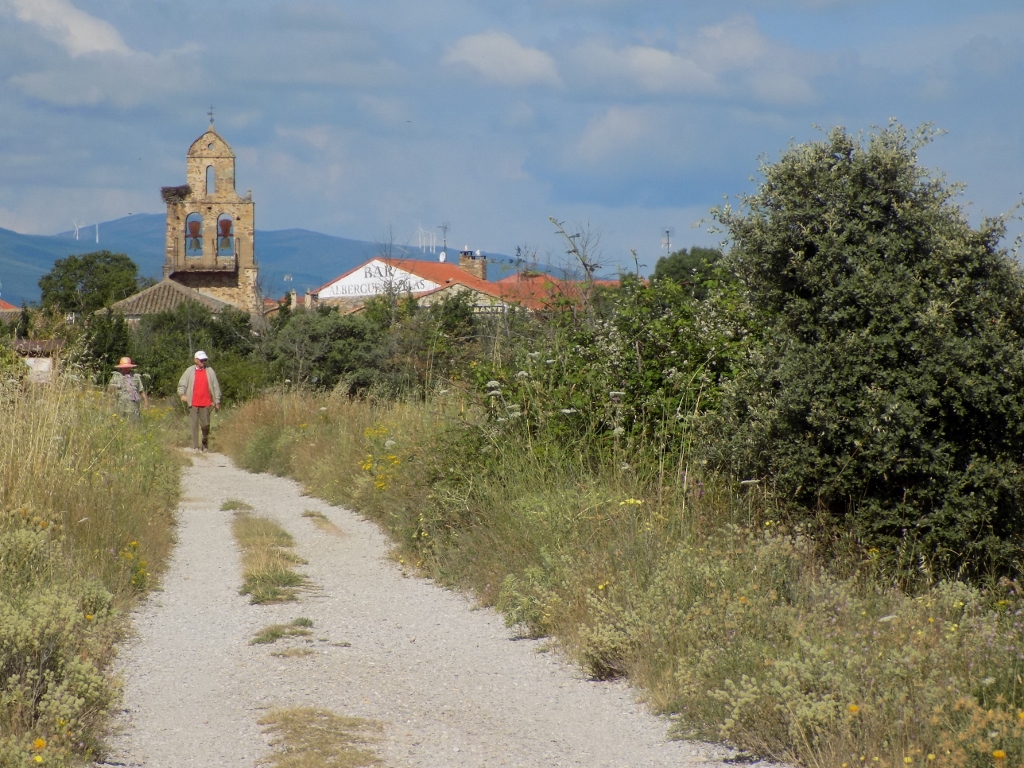 Close to Santa Catalina de Somosa
Close to Santa Catalina de Somosa
This was yet another pretty village through which the Way goes, but as opposed to the previous one I did stay here for a while since Francesco and Gabriel were already sitting in a local bar, waiting for me to join them.
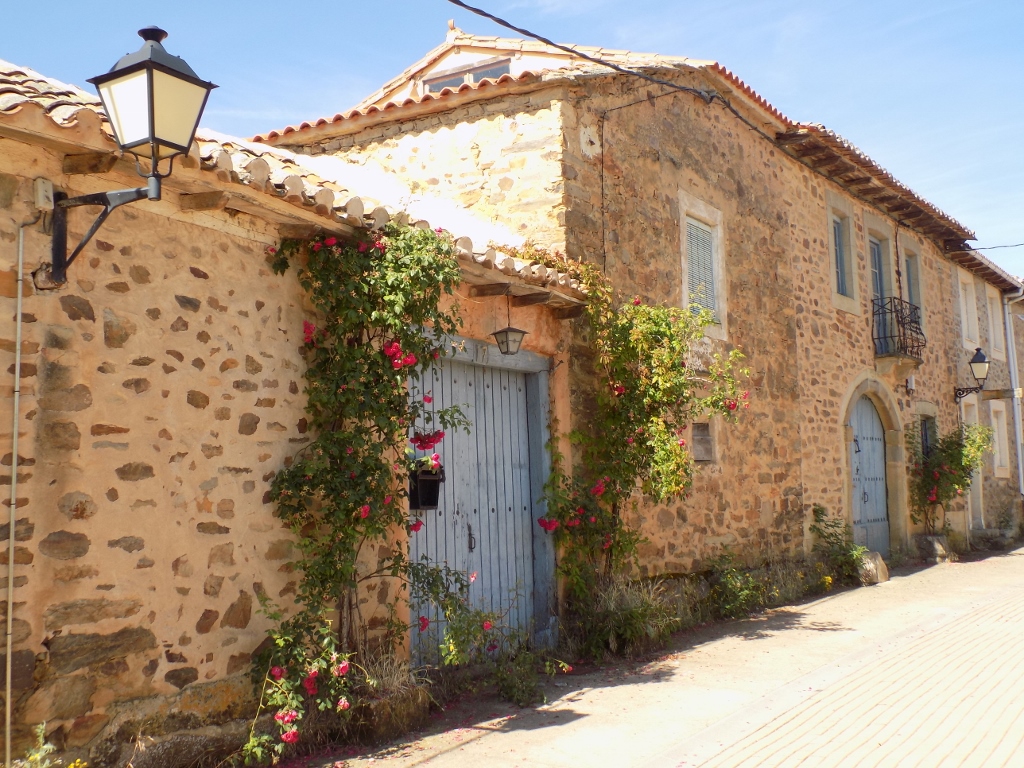 Santa Catalina de Somosa
Santa Catalina de Somosa
The rest of the walking this day took me through the landscapes that were similar to those seen before – apart from the meadows and fields that mostly stretched along the plateau across which the Way goes, it was possible to see forests and forest-covered mountains in the distance.
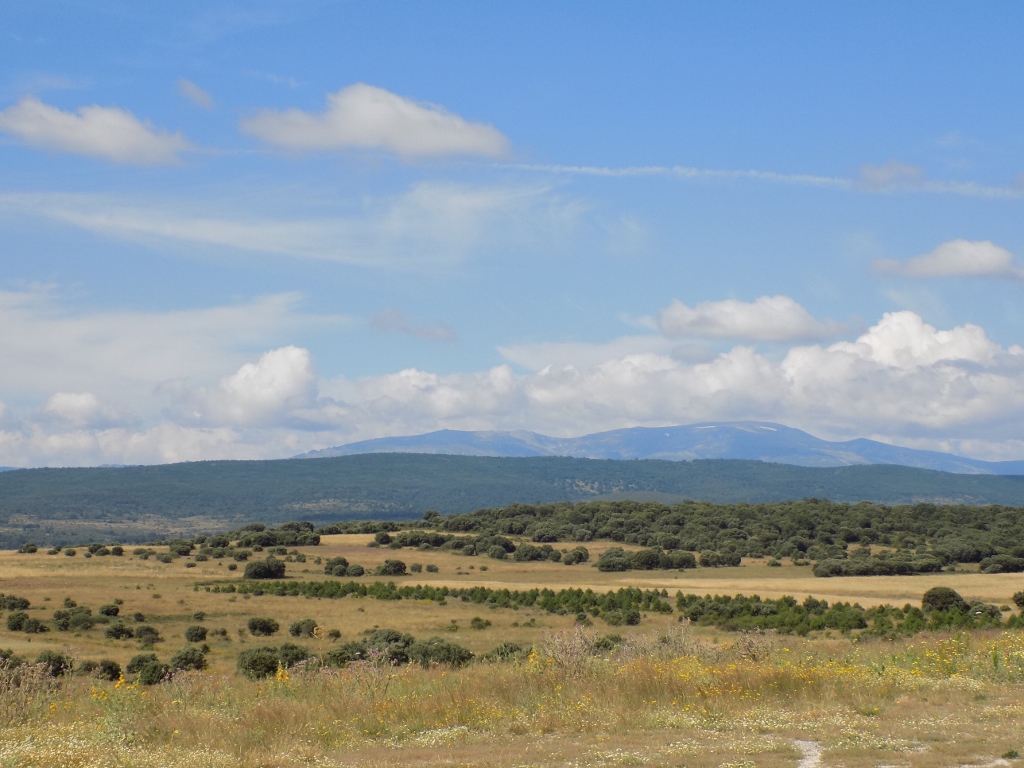 Landscapes before getting to village El Ganso
Landscapes before getting to village El Ganso
And then we reached the destination of the day and that was a village with an interesting name – El Ganso, which means “the gander.” The place is located at 1000 m above sea level and the temperature was ideal. Regardless of the beauty of the landscapes I was going through this day, the tiredness and painful tendon did their thing and I just wanted to rest, but I also wrote for my friends on Facebook:
Day 25: “Walk, Eat, Sleep”
Somewhere at the beginning of the 21st century, an American author wrote a book that would become very popular, so much so that it also had a film adaptation, and it all comes down to a contemporary escapist fiction that talks about a visit to Italy (which the Americans adore, after all like the well-off Anglo-Saxons before them), followed by a spiritual attempt, where else if not in India, and then it all ended at an exotic destination where the whole story was crowned with love “till death do them part.” The name of this romance novel consisted of three verbs in the infinitive. Still, all of this is piece of cake, a child’s play, a walkover, call it what you will, in comparison to the following three verbs in the infinitive that are taking place here every day: Walk, Eat, Sleep!
We have caught the rhythm again – getting up at dawn, walking, eating along the way, as well as later when we get to the hostel of choice, where we rest in incredible amounts, including also an afternoon nap, and then we go to bed very early in order to do more of the same the following day. And this has been happening essentially in the same manner for almost a month. Every day. Simply, there is no space for anything else.
Admittedly, today we even had a visual enjoyment since Astorga, a town we went through, is very pretty. In addition to the impressive Cathedral, there is also a building designed by famous Gaudí. The rest consisted of the usual – the first 11 km we walked without stopping, then we sat in a bar to have breakfast, then some more treading, going through a village, then we went to a bar in the next one in order to rest and get refreshed, and then we continued to the destination of the day. Eventually, I arrived here rather beat-up, but after taking shower, washing laundry and putting it out to dry, I could get into bed and indulge in the joy of the modern world, aka, the internet. The internet connections are not equally good in all the pilgrims’ hostels and they don’t reach all the corners of the place, so I’m very content when I can remain in a horizontal position and yet be able to see what is happening, or to write, or to plan the next day.
As far as the walking is concerned, yesterday we met some young Italians who covered as many as 40 km one day, but Trio La Kampanela is walking at its own pace – suffice to walk on an average 23-24 km a day in order to reach Santiago on the day we want. The good thing when you carry all of your belongings with you is that you can stay wherever you feel like, but you can also, if you are not too tired, continue to the next place. I cannot do that, because every day I send my big backpack to wait for me in the exactly selected hostel. Luckily, I fit very well with Francesco and Gabriel, and we first select the place where we are going to spend the night the following day and only then I arrange for the transportation of my backpack.
We have chosen well for today – a small albergue that has a garden, a nearby small grocery shop and the place where we would have our dinner, but it is also good that they have duvets here, since it is rather cold inside, regardless of the Sun outside and the temperature of 24 degrees Celsius. After all, we are at over 1000 m above sea level.
In front of me: 259 km
Behind me: 608 km
While I was posting my text on the internet, Francesco and Gabriel went to eat something and when they came back they said somebody had just told them Angela was about to arrive in the village. It was all absolutely incredible!
Then we had the afternoon nap, after which the two of them went out again for a walk in the village and a drink. At some point they returned and there with them was – Angela! Again, this was a wonderful and joyous reunion. Although her plan was to arrive in Santiago four days ahead of us, it was obvious that the people she was meeting on her Way were sufficiently inspiring and she made different breaks than us. Moreover, that afternoon she was walking with a woman from France. Namely, at this time, Angela was doing completely opposite from us – she did not leave early in the morning, but rather she walked later in the afternoon. Since it was getting dark only after 10 pm, she had sufficient time to get to the planned destination, but because of such walking plan she could not stay with us for long and soon she moved on.
Afterwards I also went for a walk to the nearby shop and the exit from the village, since I wanted to see which way I should follow in the morning, lest I got confused or, heaven forbid, lost. Namely, I agreed with my co-pilgrims that the following morning I would not join them in terms of starting from the albergue in the pitch black. This was Francesco’s third pilgrimage and Gabriel’s second, so perhaps they did not care as much as I to look at the nature around them. Since I wanted to do that, I did need the daylight.
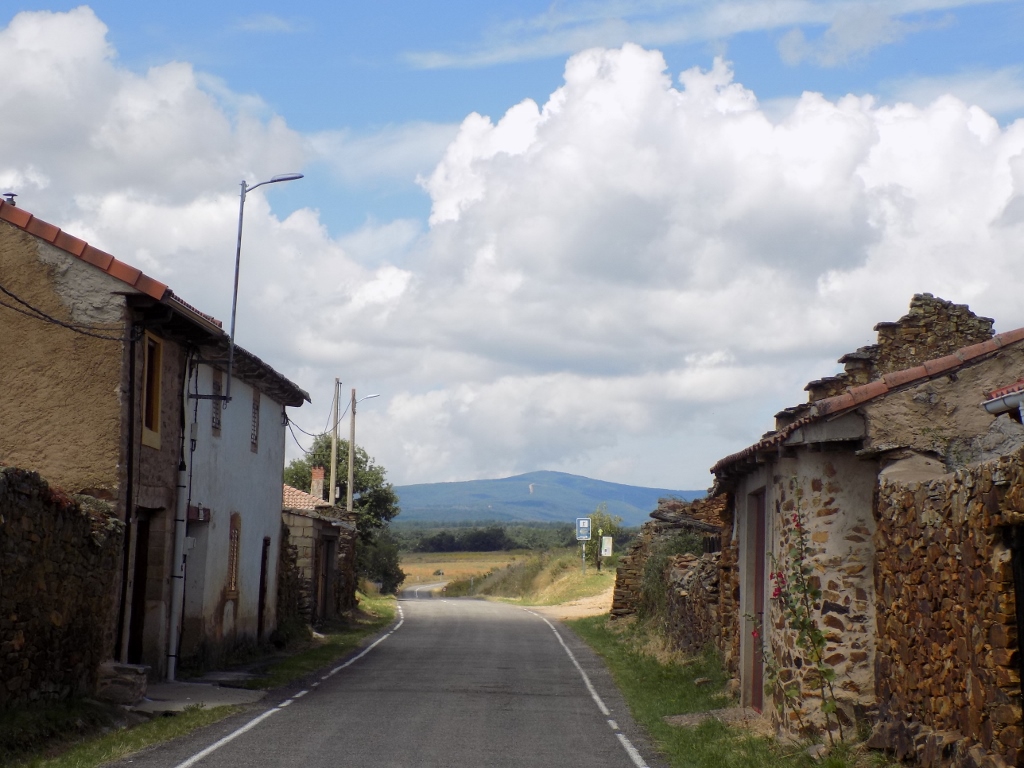 There is the sign that one should go to the right
There is the sign that one should go to the right
By the way, we had a very nice company at the albergue in El Ganso – the three of us, a guy from Hungary, a girl from Belgium and two Korean girls. We all signed up for the communal dinner and the dinner was great. The starter was particularly impressive, a fantastic mixed salad, although the tasty home-made cured meat products we got later were not bad at all.
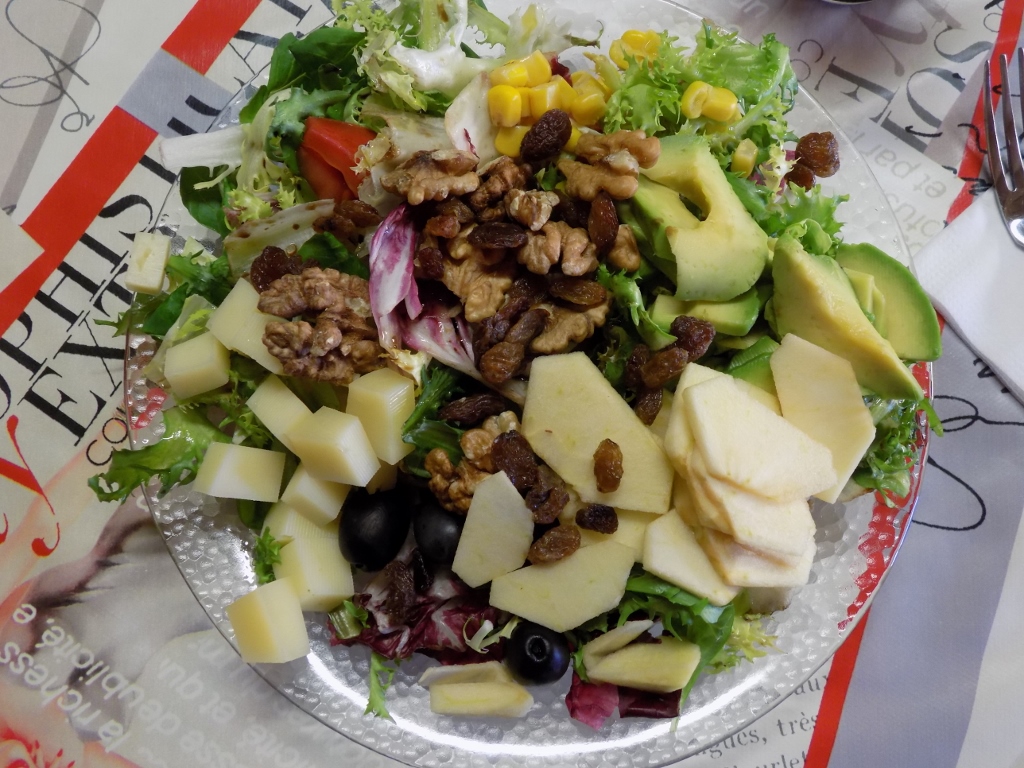 First part of the dinner
First part of the dinner
I remember especially fondly the nice and interesting chatting with Adam, a young Hungarian from Szeged. He was a lot of fun, knew a word or two in Serbian, and actually it turned out that his father was born in Novi Kneževac and even studied in Sarajevo, but he moved from the then Yugoslavia to Hungary and started his family there. In other words, Adam and I were almost compatriots! And he was certainly my closest neighbour of all the people I met on my Way – we live only some 220 km away.
The following morning, as planned, I left around 6 am. The Sun was still not up, but the dawn was in full swing and I could see both in front of me and around me. Admittedly, in the first section there was nothing particular to see, the Way stretched parallel to an asphalt road, but the morning was nonetheless magical since there was a lot to hear. Have a listen:
After a while I reached Rabanal del Camino, but before entering the village I passed by a church – Ermita de la Vera Cruz. Everything still exuded perfect peace and calmness.
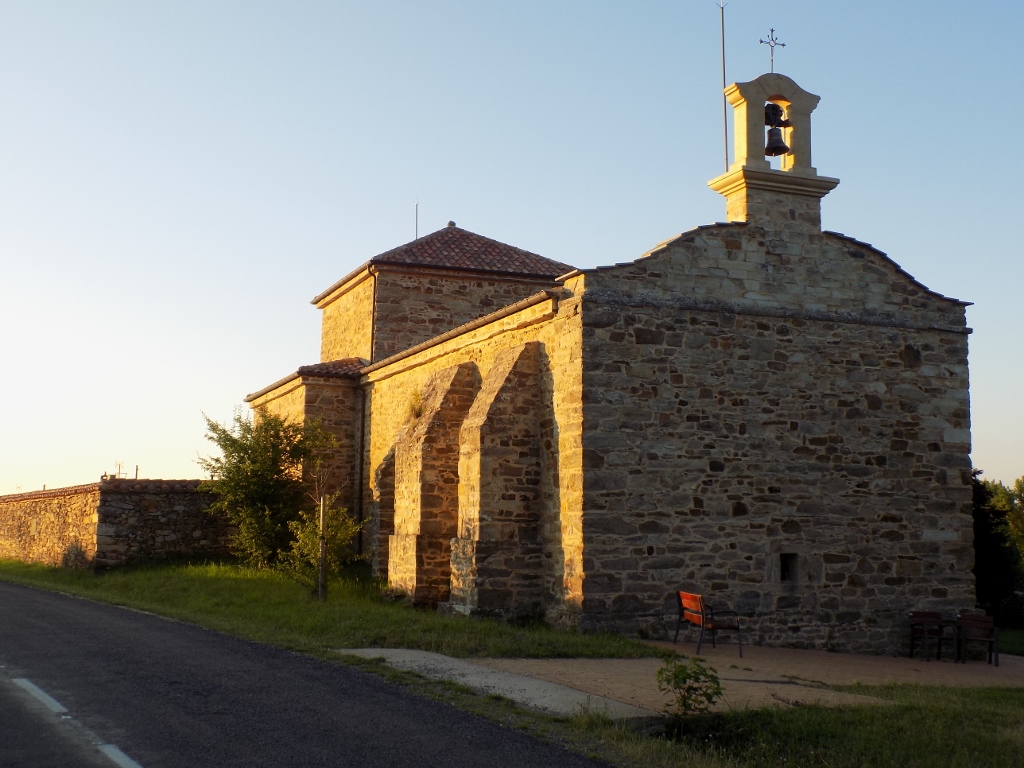 Ermita de la Vera Cruz
Ermita de la Vera Cruz
The village itself was very picturesque, but this early in the morning it seemed almost entirely deserted. I could see only a couple of pilgrims in the distance in front of me.
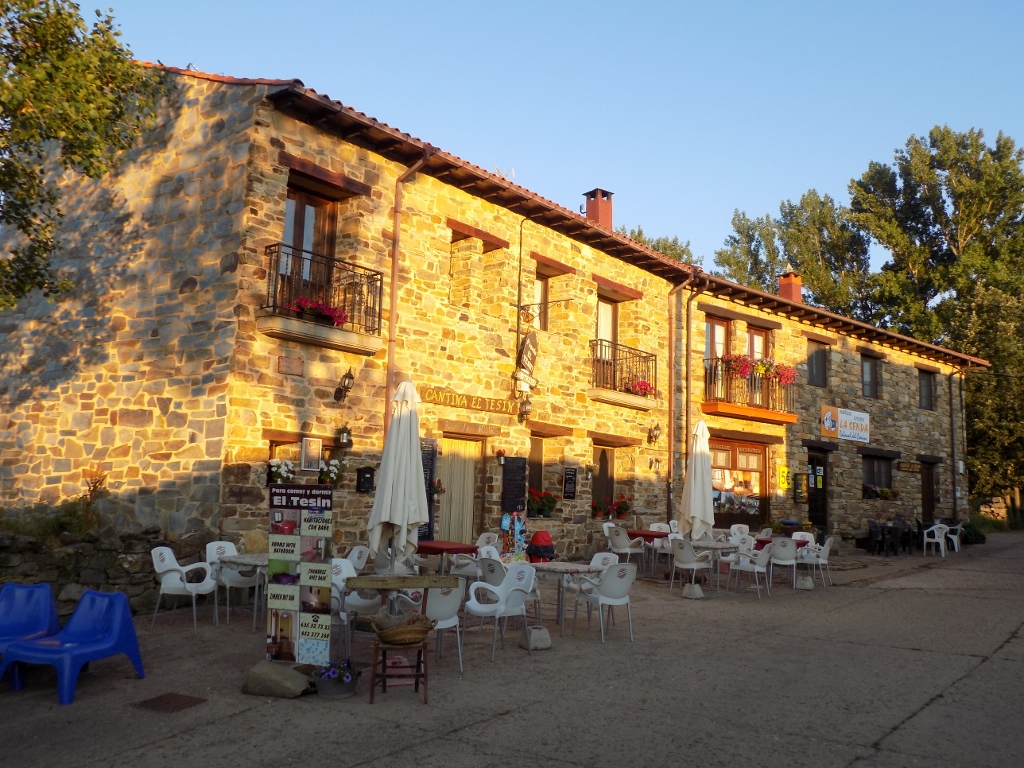 Rabanal del Camino
Rabanal del Camino
When you leave Rabanal del Camino, during a short section, the Way is wide with low vegetation and rare trees growing around it. Thus I came across a very pretty, but very poisonous plant called foxglove (Digitalis purpurea). When I posted a photo of this quite attractive plant on my Facebook profile, my dear friend Rade (top-level expert for pharmacy) immediately informed me that I should not touch the plant under any circumstances, since the toxins contained in the plant may cause the heart to stop! It is interesting, on the other hand, that these same poisons in their processed form are used for heart medicines.
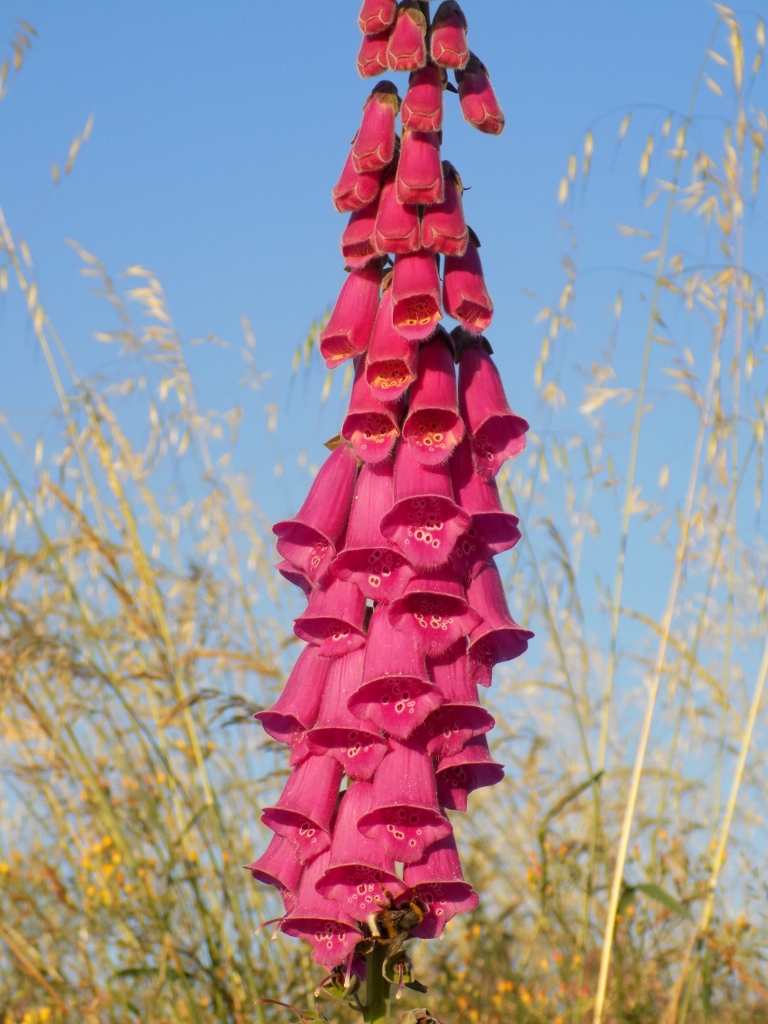 Foxglove (Digitalis purpurea)
Foxglove (Digitalis purpurea)
The Way soon crosses an asphalt road and as a narrow path continues farther through lush green shrubs. Occasionally, one comes across some parts covered in very shallow water, not in the form of a stream, but rather dispersed around, so it was important to pay attention lest one ended in some mud.
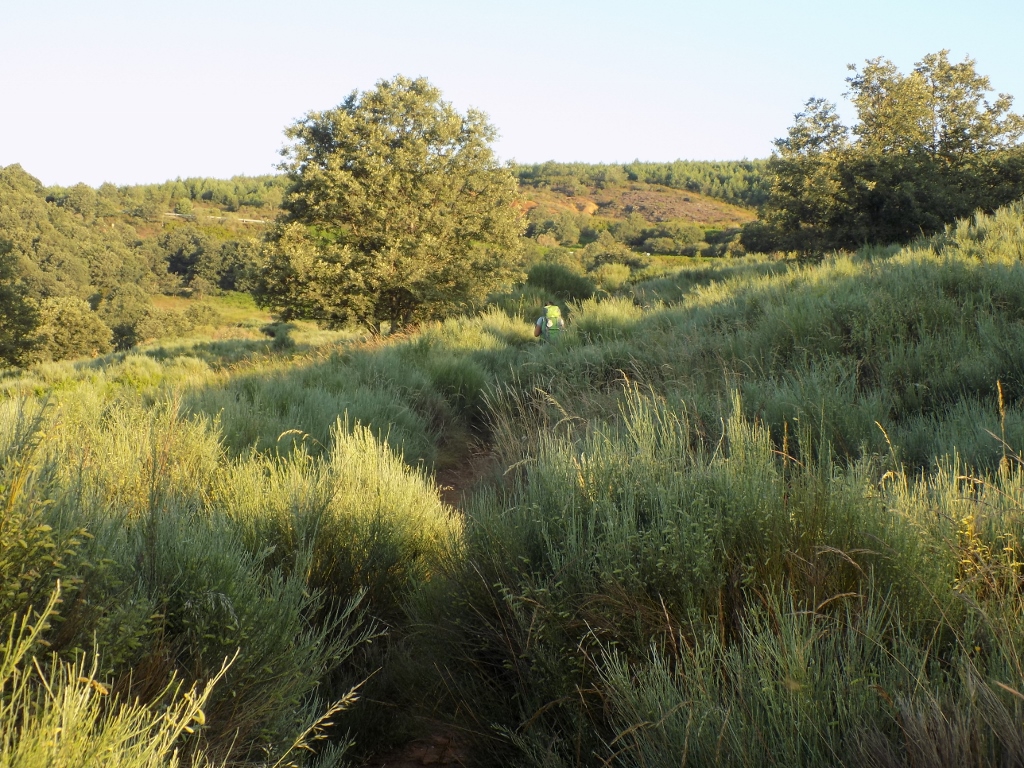 The Way is now a narrow earth path
The Way is now a narrow earth path
Then the Way crossed the asphalt road again and led into a forest. There I came across Ivana from Croatia. We greeted cordially and then I continued following my own rhythm that was quite satisfactory taking into consideration that this was a relatively steep section. At some point, the forest ends and not far from there one gets to a small village Foncebadón.
I entered the village rather leisurely and on both sides of the main street which is a part of the Way there were bars and hostels, so I was looking around in order to decide where I would make a break and have breakfast. And then, in a bar ahead of me, I saw – Gabriel and Francesco! Now I cried out and called them, so we rejoiced at getting together again. I was impressed with my walking pace, since I left one hour after them and yet I managed to catch up. They stayed with me for a short while and then they moved on.
Still, before leaving, they told me that Angela was also in Foncebadón, for she had arrived there the previous evening and again accidentally (!) they saw her as they were passing by her albergue. After breakfast and the break, I went back to the albergue where Angela was staying in order to greet her. A wonderful girl!
After Foncebadón one has to continue walking up, but it was not too bad. On the other hand, it was fantastically beautiful, because behind me there was a stunning view at the landscapes I had walked through during the previous couple of days.
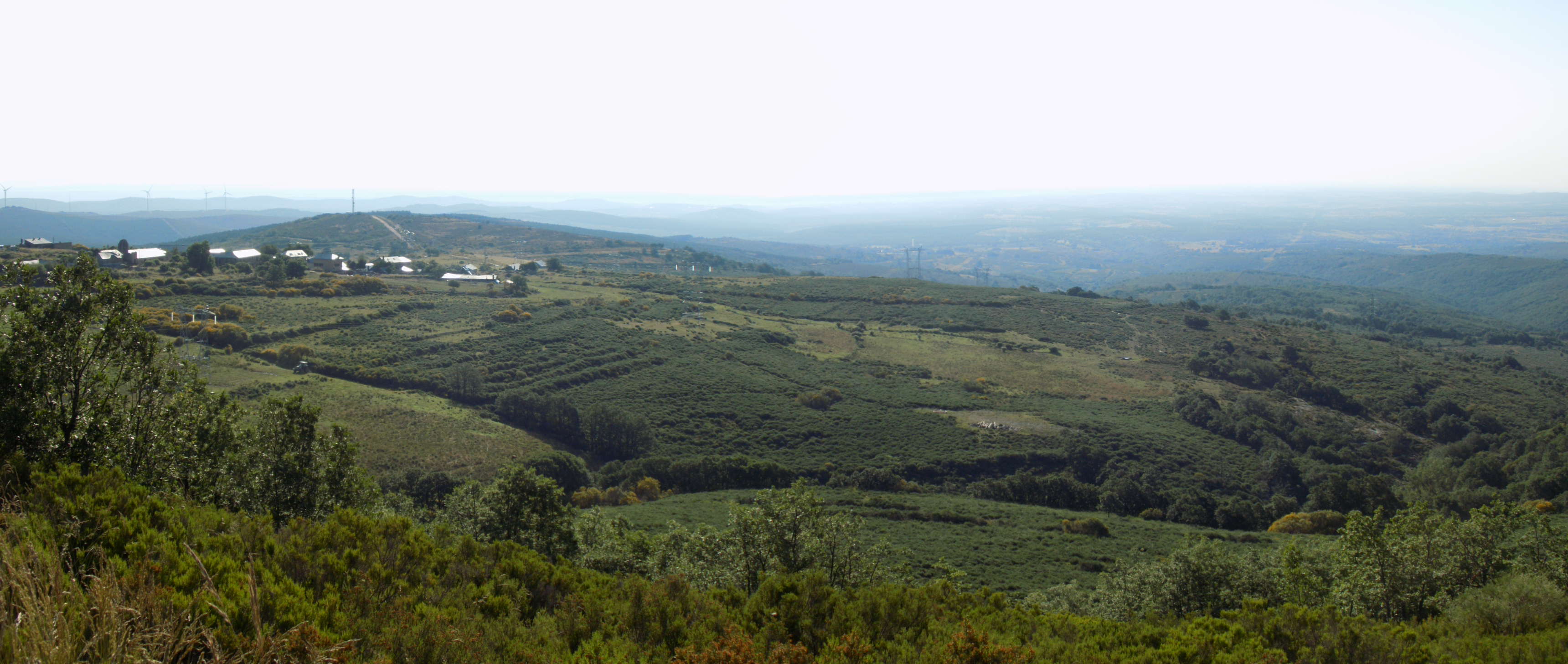
Less than 2 km after Foncebadón, you get to one of the most famous points on the Way of St James and that is The Iron Cross (La Cruz de Ferro). This is one of the oldest and the most legendary monuments on the Way. On a wooden pole, around 7 metres high, there is an iron cross, while on the bottom there is a mound made of stones left there by the passing pilgrims. Namely, the legend says that at the time when the Cathedral in Santiago de Compostela was being built, the pilgrims were asked to bring a stone each. This also transferred later to the site where the Iron Cross is located, on mount Irago, and the pilgrims either bring a stone from the place where they live or they pick up a stone along the way and then they leave it here as a symbol of their pilgrimage.
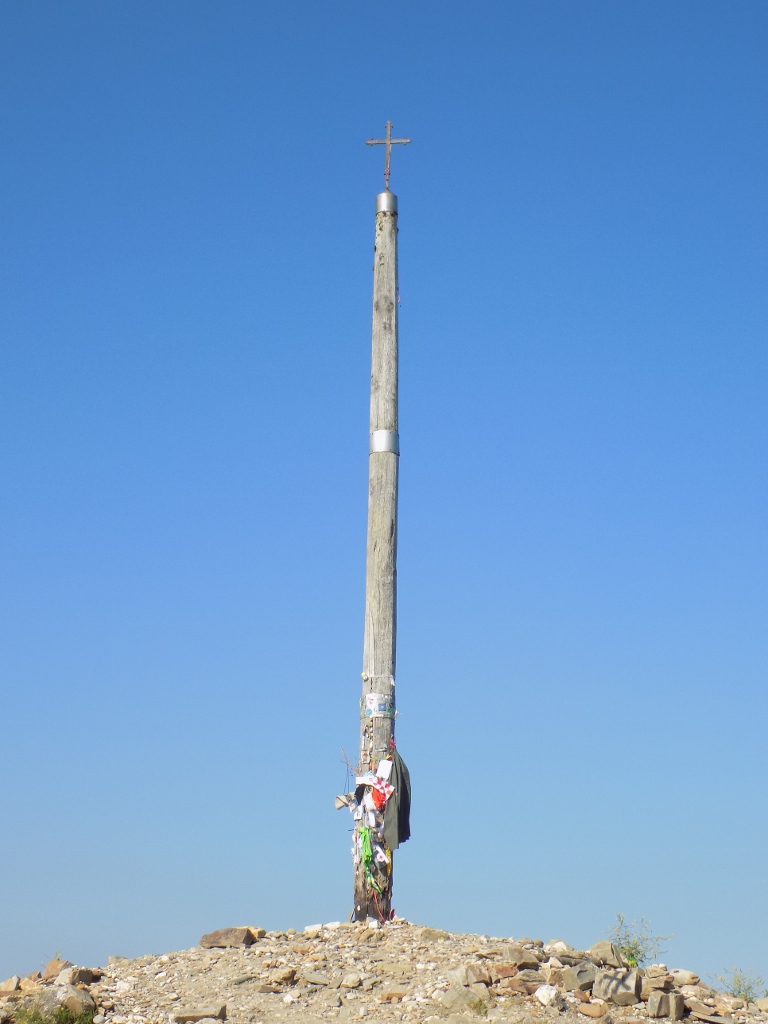 The Iron Cross (La Cruz de Ferro)
The Iron Cross (La Cruz de Ferro)
There I came across numerous pilgrims, Francesco and Gabriel included. I hanged around a little by the monument, during which time we all took photos, and then I first continued walking with the two of them, but soon I stayed behind in order to take some more pictures of the landscapes I was walking through. In this section, around 5 km long, one walks over a plateau and also crosses the highest level in this part of the Way (1,505 m above sea level).
